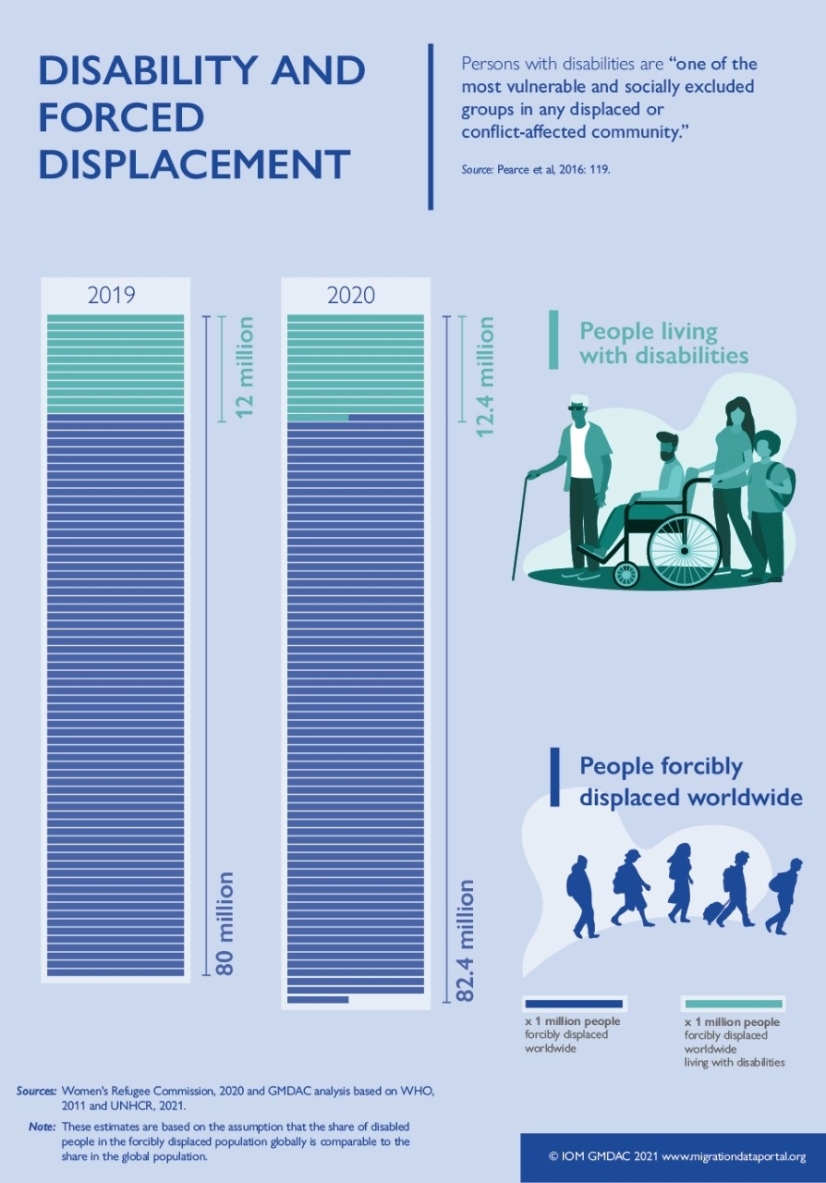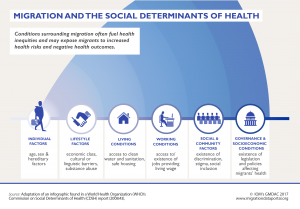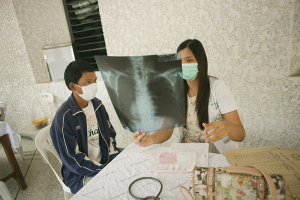Disability and human mobility
Persons with disabilities are often among the most vulnerable and disproportionately affected groups in migration and forced displacement situations. Within the population of persons on the move with disabilities, subgroups like older migrants and women and girl migrants with disabilities are particularly vulnerable. It is known that the migration and forced displacement processes can create disabilities or worsen existing ones. Yet, knowledge on migration or forced displacement and disability is limited because data on disability are often not collected. When they are, methods for collecting data are not standardized which makes comparing data across countries difficult. How disability is defined also poses a challenge when trying to compare existing data. The criteria for defining disability for data collection purposes also differs across countries and organisations.
No official international statistics exist on the global prevalence of disability within the persons on the move population; at best, there are estimates. In 2020, an estimated 12 million people in the forced displacement population were persons with disabilities, but the prevalence is likely higher (GMDAC analysis based on UNCHR 2020 and WHO 2011)1.
In general, existing data sources on persons on the move with disabilities provide information at the national or local levels, or on particular groups or subgroups. Data gaps like the lack of available or timely data, lack of harmonized datasets and collection methods, along with the challenges in defining disability to compare cross-country datasets, need to be addressed to help provide a clearer global picture of human mobility and disability for policymaking and program implementation, as well as track related targets in the Sustainable Development Goals.
Definition and concept
The definition of disability has evolved over time and has included charity and medical models. In the medical model, disability is defined by someone’s impairments or deficits in bodily functions. A rights-based approach is the cornerstone of the Convention on the Rights of Persons with Disability (CRPD) which states that:
“[…] persons with disabilities include those who have long-term physical, mental, intellectual or sensory impairments, which in interaction with various barriers may hinder their full and effective participation in society on an equal basis with others.”
This definition of the disability is consistent with the conceptual framework of disability included in the World Health Organizations (WHO)’s International Classification of Functioning, Disability and Health (ICF). The ICF’s conceptual model of disability is the basis for the questions sets developed by the Washington Group on Disability Statistics which includes the Washington’s Group Short Set (WG-SS) of 6 questions on functioning. The WG-SS has become the international standard for collecting data on disability particularly for disaggregation, including on persons on the move with disabilities (see data sources section below).
The language used in data collection tools to identify the population with disability (including how questions are translated or interpreted) and stigma that can be associated with disability also affect how both the persons conducting the data collection and the person on which data are being collected understand the intent of the questions. This can introduce variability in the data collected which reduces or eliminates the validity of the information.
Selected key findings
- According to WHO and the World Bank (WB) and based on the methodologies used, 15 per cent of the world's population are estimated to experience some form of disability (WHO, 2011). At the time of the WHO and WB report, this translated to more than one billion people worldwide; nearly 200 million of these persons with disabilities, experienced considerable difficulties in functioning (Ibid.).
- No official international statistics exists on how many persons on the move are also persons with disabilities. However, based on the WHO’s and WB’s 15 per cent global disability prevalence rate statistic, an estimated 12.4 million of the 82.4 million people who were forcibly displaced globally at the end of 2020 were persons with disabilities (IOM analysis based on WHO, 2011 and UNHCR, 2021)2. In 2019, this estimate was 12 million of the nearly 80 million people forcibly displaced globally were persons with disabilities (Women's Refugee Commission, 2020). While 15 per cent has been the global disability prevalence that has also been applied to the forcibly displaced population, country specific surveys such as the Syria Disability Impact and Prevalence (2019) suggest prevalence of disability among the forcible displaced populations could be higher.
Covid-19 and disability
- For migrants with disabilities, the COVID-19 pandemic brought additional challenges on top of existing social, economic, environmental and political barriers. Migrants with disabilities were at higher risk for hunger and deprioritised for COVID-19 related treatments, had less means to meet their increased need for hygiene products, had limited access to necessary health services and vaccination, lacked health information and treatment, and had an increased risk of acquiring COVID-19 because of shutdowns, isolations, and other pandemic-related restrictions (IOM, 2020 and IDA, 2020).
Highlighted research
While there are no official global estimates on the number of mobile populations with disabilities, some country examples include:
- South Sudan:A 2019 survey conducted by IOM’s Displacement Tracking Matrix (IOM DTM) and Humanity & Inclusion (HI – formerly Handicap International) in the Wau Protection of Civilian Adjacent Area Site (PoC AA), in South Sudan, showed that 14.4 per cent of respondents were persons with disabilities, as identified by the WG-SS of Questions, while an estimated 18.7 per cent of households include at least one member with a disability (IOM DTM and HI, 2019).
- Mexico:According to a report by Mexico’s Population Council (Consejo Nacional de Población - CONAPO, in Spanish) and the Migration Policy Unit (Unidad de Política Migratoria - UPM, in Spanish) of the Secretariat of Government, 22 per cent of Mexican returnees from the United States had a disability or impairment. Data, however, are not disaggregated into types or causes of disability (CONAPO, 2018).
-
El Salvador, Honduras, Colombia, Ecuador and Peru:According to a HelpAge International and UN Refugee Migration Agency report that evaluated the situation of older persons on the move, including those with disabilities, 48 per cent of older person with disabilities interviewed in four Latin American countries reported being abused in the countries where they reside. as well as before the pandemic. In contrast, 29 per cent of older persons interviewed and without disabilities reported abuse. The abuse among older persons on the move with disabilities was higher in specific countries. In Honduras and El Salvador, 63 percent of respondents reported being victims of abuse, but the proportion increased to 87 percent for older persons with disabilities.
- Syria: According to the Disability Prevalence and Impact Report in Syria (HNAP, 2021), persons with disabilities represented 25 percent of the population, which has a high prevalence of internal forced displacement and people on the move.
Data sources and methodology
The 2011 World Report on Disability from the WHO and the World Bank was the first document to report on the global picture of persons living with disabilities and its estimate on the global disability prevalence were based on two key sources: the World Health and Global Burden of Disease studies. However, these sources do not focus specifically on migrants living with disabilities and their related datasets are not disaggregated to identify migratory status. In addition, the estimates reflect the manner in which the available data were modelled and the cut-point used to identify the population with disabilities. Different model assumptions and different cut-points would have produced different prevalence estimates.
While there are no official data sources on the global prevalence of persons on the move with disabilities, there are:
- (1) Key tools and initiatives to standardize and promote data collection on disability at the international level that can be applied in the migration context; and
- (2) Data sources that provide information at the national or local levels and/or are focused on particular migrant and refugee groups or certain migration contexts.
(1) Key tools and initiatives
- The Washington Group Short Set on Functioning (WG-SS): The WG-SS is the internationally accepted standard tool for collecting disability data particularly for identifying the population with disability for disaggregation, including in migration and forced displacement settings. The WG-SS is a set of six, cross-nationally comparable questions originally designed for national census and survey use, but have also been used by non-governmental actors, including international organizations working with migrants.3 Six domains of functioning are included – seeing, hearing, walking, cognition, communication, and self-care – with answer categories that provide information on the range of functional difficulties. Since the adoption of the WG-SS, the WG has developed, extensively tested, and validated additional tools for the collection of internationally comparable disability statistics that can also be applied to the migration and forced displacement fields such as the Washington Group Short Set - Enhanced and the Washington Group Extended Set on Functioning as well as the Washington Group-UNICEF Child Functioning Module (CFM).The WG’s data collection tools can be incorporated into ongoing national data collection systems, as well as topic-specific surveys, programmatic, and research data collections. Nevertheless, the WGQ-SS has not been used across different contexts by all actors and are sometimes adopted in an ad hoc manner. Failure to adopt the accepted common methodology to collect disability related data hinders efforts to benchmark and monitor progress on disability inclusion policies and the implementation of national and international agendas related to persons with disabilities.
- WHO Disability Assessment Schedule (WHODAS 2.0)- Applicable cross-culturally, the WHODAS 2.0 is a generic assessment tool that provides a common metric to measure health and disability at the population or individual levels. Like the WG-SS it is based on the ICF. Unlike the WG-SS, the questions in the different versions of the WHODAS run from 12 to 36 questions.
- WHO’s Model Disability Survey (MDS) – Based on the ICF and developed by the WHO and the WB, the MDS, is a full length, targeted disability survey designed to and provide comprehensive information about the levels of disability in a population, unmet needs. barriers and inequalities faced by people who experience different levels of disability.
- World Bank’s Guidebook on Disability Measurement in Household Surveys: This guidebook supports the implementation of the WG-SS and aims to assist National Statistical Offices in the design and implementation of multi-topic household surveys.
- United Nations Disability Inclusion Strategy (and policy and action plan) - Initiated in 2018, the UNDIS establishes objectives and goals to fill the gaps inhibiting the mainstreaming of disability, including across all pillars of the UN. It recognizes that the “lack of disability-related data, including qualitative and disaggregated data, is one of the major barriers to the accurate assessment of disability inclusion in the development and humanitarian contexts.”
- Charter on Inclusion of Persons with Disabilities in Humanitarian Action: A document endorsed by more than over 70 stakeholders from States, UN agencies, the international civil society community and global, regional and national organisations of persons with disabilities that commits, among other things, to “[a]dopt policies and processes to improve quantitative and qualitative data collection on persons with disabilities” and “[e]nsure that data collected on persons with disabilities is disaggregated by age and sex....”
- Global Partnership for Sustainable Development Data (GPSDD)’s Inclusive Data Charter (IDC): An initiative developed in 2018 by GPSDD partners to “mobilize political commitments and meaningful actions to advance inclusive and disaggregated data” and to “advance the availability and use of inclusive and disaggregated data so that governments and organizations better understand, address, and monitor the needs of marginalized people and ensure no one is left behind.“
- IASC Guidelines on Inclusion of Persons with Disabilities in Humanitarian Action sets out key actions that humanitarian actors need to consider to effectively identify and respond to the needs and rights of persons with disabilities who are most at risk of being left behind in humanitarian settings. The Guideline’s Data and Information Management chapter covers subtopics such as why disability data should be collected and tools to desegregate data by disability.
- DTM Partners Toolkit- Field companion on Disability Inclusion: Developed by experts from IOM, UNHCR, UNICEF, Humanity International and Oxfam, this tool identifies common information needs for disability inclusion data, focuses on barriers faced by persons with disabilities in accessing basic goods and services, and is applied to IOM’s Displacement Tracking Matrix methodology.
For additional tools and initiatives, see the further reading section below.
(2) Key data sources
(a) Selected international/Intergovernmental and disability organizations
Some international and/or intergovernmental organizations that work on migration collect data and information on migrants and refugees with disabilities, and this work is often supported through partnerships with disability organizations.
- Office for the Coordination of Humanitarian Affairs (OCHA)’s Humanitarian Data Exchange (HDX) - Launched in 2017, the HDX is an online platform for finding, using, and sharing humanitarian data. The platform comprises nearly 10,000 datasets, including about 25 datasets that include data on disabilities, some of which are relevant to forced displacement contexts.
- International Organization for Migration’s Displacement Track Matrix (IOM DTM) is a tool that gathers and analyses data to generate multi-layered information on migrant populations. In 2019, DTM joined efforts with Humanity & Inclusion to provide a quantitative estimate of the prevalence of disabilities among the IDP population and an assessment of barriers faced by persons with disabilities in accessing humanitarian services in the Wau Protection of Civilian Adjacent Area Site (PoC AA) in South Sudan. Read survey’s results.
- United Nations Refugee Agency (UNHCR) – With support from partners like Inclusive Humanitarian Action, UNHCR uses the WG disability tools to collect data and information on disabilities among the refugee population and shares it on its Operational Data Portal.
- United Nation’s International Children’s Emergency Fund (UNICEF) – Through its large presence in the field, UNICEF collects data on children in the humanitarian setting, including child IDPs and refugees. In its Including Everyone report, UNICEF reviews the state of data collection on disability in Nepal, Somalia, Bangladesh, and the European Union.
- Humanity & Inclusion (HI) is an independent, impartial aid organisation which advocates for the universal recognition of the rights of persons with disabilities and other vulnerable populations and is specialised in data collection and analysis of these groups. With the data gathered through its 2018 survey on Syrian refugees, HI built a data dashboard providing statistics on people with disabilities among Syrian refugees and their access to humanitarian aid.
Other key disability organizations that partner with International/intergovernmental organizations to collect data and information on migration and disability, include the Women's Refugee Commission Disability Inclusion Programme, HelpAge International and organizations that are members of the International Disability Alliance.
(b) National censuses and household and health surveys
Some countries, especially high-income countries, collect both data on disability and migratory status through their national censuses and household surveys. But while most countries collect data on migratory status, the collection of disability data is less frequent than the collection on migratory status. Between 2010 and 2020, 111 countries had implemented the WG-SS in their censuses or surveys, according to the information provided by WG members in 2021. The number of countries including disability questions in census might increase with the 2020 round of census although COVID-19 has caused the postponement of census data collection in some countries.
When compared to national censuses, national household surveys such as those that collect information on demographics, health and labour, are better sources for more specific information on migrant and refugees living with disabilities. However, these sources need to have a large enough sample to allow for disaggregation by migration and disability status and include questions that allow for the identification of both populations.
(c) Rapid assessments after emergencies
Humanitarian agencies working in conflict-induced and/or disaster-induced displacement contexts, sometimes collect information through rapid assessments on displaced persons with disabilities. These rapid assessments are useful for identifying persons with disability and gaps in responses.
(d) Research projects and case studies
Research projects and case studies on migration and disability conducted by international and intergovernmental and/or disability organizations are growing. These studies are found on those organizations’ respective websites, in research journals and online platforms, such as IOM’S Migration Health Research Portal.
(e) Case management data
Case management data from social service agencies that work directly with migrants with disabilities may also collect disability data at the individual and household levels which are relevant to program design, implementation and evaluation.
Back to topData strengths and limitations
- Data collections efforts, whether through censuses, household surveys, administrative sources or research projects may collect data on either disability or migratory status, but not always on both. Also, when data on migrants with disabilities are available, they may not always provide detailed information such as age, gender, kind of impairment and/or living condition, to inform migration and disability policies.
- Data from censuses may no longer reflect the current reality of migrants with disabilities in the country, as census are usually conducted every 10 years.
- Datasets may not be directly comparable, as they derive from censuses and surveys that might have been conducted under different circumstances and methodologies, covering, for instance, different time periods or asking non-standardised questions (Leonard Cheshire Disability and the UK Aid, 2018). The sampel size for surveys can also be too small to allow for disaggregation by migration and disability status.
- Data available may not always use the same definition of disability or standardized questions, limiting data comparisons within and across countries. In addition, data on persons with disabilities are often collected for specific purposes, like providing social security support, and therefore the questions in the data collection tools cover only the programmatic eligibility criteria. Defining who is a migrant also has its challenges which affect data collection. Read more
- Disability policy and migration policy, and consequently the related data collection and use, sometimes remain siloed in certain government ministries although the issues are relevant to other policy areas like health and education. Both disability and migration are cross-cutting issues that affect all aspects of life. Harmonization in the collection of disability and migration data would allow data from multiple sources to be analysed together.
- Local social service agencies that work with migrants with disabilities and collect data, often lack resources to mainstream their data collection. Their information management systems (IFM) could be outdated or disconnected from national IFMs.
- Rapid assessments during post-emergency situations may collect data on forcibly displaced persons but perhaps might not offer as much detailed data because the collection of data needs to be fast and therefore the data collection tools do not allow for additional questions that would help analysts disaggregate the dataset by many variables.
- The prevalence of disability within the migrant populations may be underreported because:
- Data collection relies heavily on the migrant themselves or family members to identify and report on disability, but migrants may not always self-report their or a family member’s disability for various reasons;
- Non-standard data collection tools that fail to identify the population of interest due to poorly constructed questions that do not address the full range of potential disabilities;
- Those collecting data may not be trained well and may only identify the “visible” characteristics that the data collector determines are disabilities. Therefore, conditions that are not immediately noticeable or considered a disability can remain undetected unless the migrant or refugee undergoes medical examinations or is given the opportunity and chooses to disclose this information (FRA, 2016).
Further reading
International Organisation for Migration (IOM)
2020 Migration and Disability in 2020. International Organisation for Migration, San Jose.
2019 South Sudan – Disability & Inclusion Survey Wau PoC AA. International Organisation for Migration’s Displacement Tracking Matrix and Humanity & Inclusion, South Sudan.
2016 Disability and unsafe migration: Data and policy, understanding the evidence. International Organisation for Migration. Global Migration Data Analysis Centre (GMDAC) Data Briefing Series, Berlin.
World Health Organisation (WHO) and the World Bank
2011 World Report on Disability, WHO, Geneva
World Health Organisation (WHO)
2018 Disability and Health. World Health Organisation, Geneva.
United Nations
2020 Persons with disabilities in the context of internal displacement. United Nations Special Rapporteur on Human rights of Internally Displaced Persons.
International Disability Alliance, UNHCR’s office for the Special Advisor on Climate Action, and the Internal Displacement Monitoring Center (IDMC)
2021 Disability, Displacement, and Climate Action: A Joint Factsheet
Emma Pearce
2015 “Ask us what we need”: Operationalizing guidance on disability inclusion in refugee and displaced persons programs. Disability and the Global South, Vol. 2, No. 1, 460-478, Malta.
The Sphere
2018 The Sphere Handbook: Humanitarian Charter and Minimum Standards in Humanitarian Response. Sphere, Geneva.
Leonard Cheshire Disability
2018 Disability Data Review: A collation and analysis of disability data from 40 countries. Leonard Cheshire, London.
Ola Abualghaib et. al
2019 Making Visible the Invisible: Why Disability-Disaggregated Data is Vital to “Leave No-One Behind”. Sustainability 2019, 11, 3091, Basel.
Olaussen, S. and Renzaho A.
2016 Establishing components of cultural competence healthcare models to better cater for the needs of migrants with disability: a systematic review. Australian Journal of Primary Health 22, 100-112.
European Disability Forum
2020 Toolkit on the inclusion of refugees with disabilities
European Union Agency for Fundamental Rights (FRA)
2016 Monthly data collection on the current migration situation in the EU. Monthly Report, Vienna.
Assembly of European Regions
2018-2020 Access to services for Migrants with Disabilities (AMiD) project (Note: AMiD has published national reports in Austria, Finland, Greece, and Italy, a need assessment tool and 4 training modules.
1 This estimate is based on the assumption that the share of disabled people in the forcibly displaced population globally is comparable to the share in the global population
2 Ibid.
3 The WG-SS focuses on functional difficulties, specifically steering away from using the word disability and does not measure barriers or the larger experience of what it is to have a disability. Other Washington Group tools address barriers and facilitators.
Back to top




